The Immigrant’s Journey: Processing at Ellis Island in 1913
📌 Discover the emotional and bureaucratic challenges faced by immigrants at Ellis Island in 1913. From medical examinations to family separations, this detailed account offers historical insights into the immigrant experience at America's busiest port of entry.
Landing at Ellis Island - Processing the Steerage Passenger (1913)
Relevance to Immigration Studies
This article provides a detailed, firsthand account of the experiences of immigrants, particularly steerage passengers, as they land at Ellis Island for processing. It offers a deep dive into the physical, emotional, and bureaucratic challenges immigrants faced upon arrival in the United States. For educators, students, genealogists, historians, and those studying immigration history, the article is a vital resource to understand the historical context and complexities of the immigration process during the early 20th century.
The narrative is particularly relevant for immigration studies as it explores the medical, legal, and social hurdles that immigrants encountered while being processed at Ellis Island, which was, at the time, the primary entry point for millions of immigrants. The description of the procedural steps taken to evaluate and detain or admit immigrants provides a clearer picture of the immigrant experience, illustrating both the human toll and the systemic operations of early 20th-century immigration law.
Chapter IX Landing at Ellis Island
No cabin passenger ever sailed through the Narrows and beheld the Statue of Liberty without feeling thrilled at the sight. If it were not the thrill of patriotic devotion to his native or adopted land, it must be a thrill of pleasure at being safely across and with a chance to set foot on solid ground so soon again. But, if the sight of the goddess stirs the cabin, what must it mean to the steerage?
To the steerage, a new world is dawning, and a week or more of earthly purgatory is ending. Dr. Steiner, the eminent immigration authority who has carried his gospel of kindness into many a steerage, himself acknowledges that he has often tried to overcome the steerage's deep despair by reminding its people that though it seems like hell, there is a heaven beyond.
He says that it is not easy to travel in the steerage, not because there is not enough room, air, or food, although that is all true, but because it is hard to believe down there that the God of Israel is not dead.
To the immigrant Ellis Island is an ordeal.
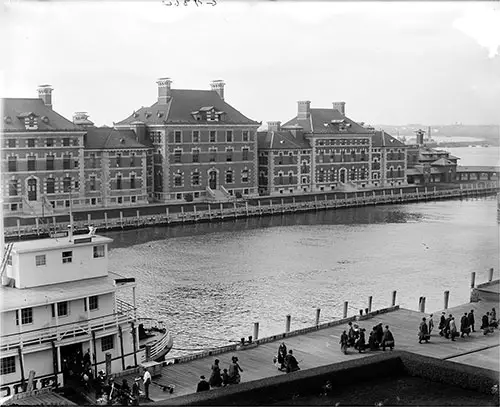
Immigrant Landing Stage at Ellis Island. Tender Brings New Immigrants to Ellis Island for Processing. nd circa 1910s. Detroit Publishing Company # 0500726. Library of Congress # 2016796928. | GGA Image ID # 14824f206a
The "man at the gate" is a big giant who can instantly speed him through or crush the life out of his hopes. A thousand lies, some useful, some useless, and some unnecessary, are prepared in the hope that they will help navigate the tortuous channel of admission to America. Passing quarantine and the customs officials as the ship comes up the bay, it is warped into its dock, and when the last cabin passenger has gone ashore, the steerage people are put into barges and towed away to Ellis Island, where final judgment awaits them.
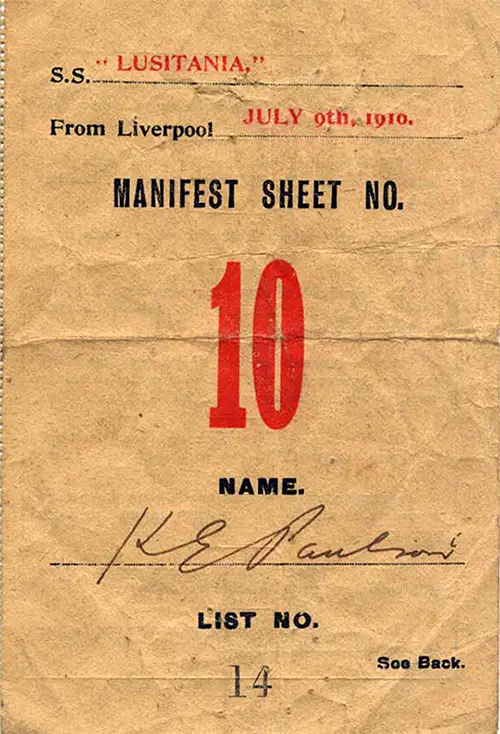
Front Side, Immigrant ID Tag. When landing in New York, this card was pinned to the coat or dress of the passenger in a prominent position. Provided to K. E. Paulson, who traveled to the United States on the RMS Lusitania, Departing from Liverpool on 9 July 1910 for New York. Listed on Manifest No. 10, List No. 14. | GGA Image ID # 1545720f6a
Their tickets are fastened in their caps or pinned to their clothes, and their bills of lading are in their hands. They are lined up in long rows when they enter, with two doctors for each row. They must walk down a narrow lane of rows of piping, with an interval of twenty feet between them.
As they approach, the doctors begin to size up each immigrant. First, they survey him as a whole. If the general impression is favorable, they look at his feet to see if they are all right. Then come his legs, his body, his hands, his arms, his face, his eyes, and his head. While the immigrant was walking twenty feet, the doctors asked and answered several hundred questions in their minds. If the immigrant reveals any intimation of any disease, if he has any deformity, even down to a crooked finger, the fact is noticed.
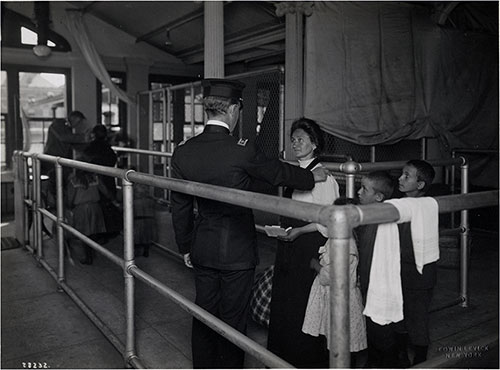
Immigrants Undergo Medical Examination at Ellis Island ca. 1908 (1902-1913). Photograph by Edwin Levick from the William Williams Collection. The Miriam and Ira D. Wallach Division of Art, Prints and Photographs: Photography Collection, New York Public Library. NYPL # 416754. | GGA Image ID # 14ea9ea1e3
If he is so evidently healthy that the examination reveals no reason why he should be held, he is passed on. But if there is the slightest suspicion in the minds of the doctors that there is anything at all wrong with him, a chalk mark is placed upon the lapel of his coat.
After passing the surgeons who examine their health tickets and bodies, the immigrants encounter the one who examines their eyes. With towels and antiseptic solutions, the surgeon rolls the immigrants' eyelids back on a round stick resembling a pencil. He is looking for trachoma. Those discovered to have it are sent away for deportation.
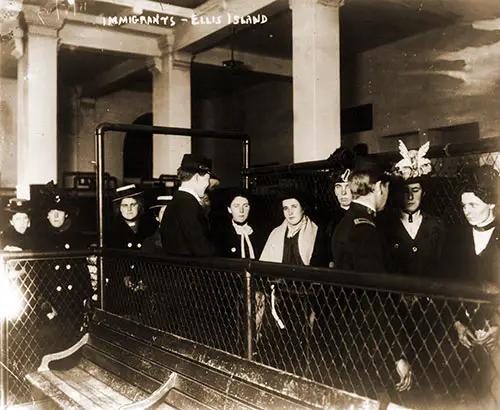
Line of Female Immigrants Undergoing Inspection at Ellis Island circa 1912. Bain News Service. Library of Congress LCCN 2001704437. | GGA Image ID # 1d9f02122b
The line moves on past the female inspector looking for prostitutes and then past the inspectors who ask the twenty-two questions required by law. Here is where the lies are told. Most of the immigrants have been coached as to what answers to give.
Here is an older woman who says she has three sons in America when she has but one. The more she talks, the worse she gets entangled.
Here is a Russian Jewish girl who has run away to escape persecution. She claims a relative in New York at an address found not to exist; she is in trouble.
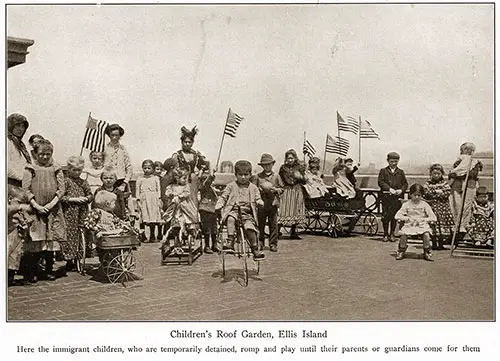
Children's Roof Garden at Ellis Island. National Geographic Magazine, May 1907. | GGA Image ID # 1d9d0c19a8
As the immigrants file by, the surgeons mark about half of them with chalk, directing them to another pen for further examination. This process, however, results in heart-wrenching scenes of families being torn apart. Mothers are in a panic, fearing they have lost their children forever; children are in a frenzy, believing they will never see their parents again. Husbands and wives are separated, left in the dark for hours about the reasons for their isolation.
After the immigrants have passed the inspectors, they face the 'stairway of separation.' This is where the journey diverges, leading to different destinations. Three stairways, each leading to a different room, symbolize the challenges and uncertainties that lie ahead for the immigrants.
The way is now open to those who have passed muster in this ordeal. They are inside the gate, and their troubles are over. But here is a room where those given tickets are marked " S. I.—Special Inquiry." This takes them to an iron-barred gate, behind which sits an official who admits them and distributes them to the various detention rooms. Sometimes, two thousand may be detained at a time.
Although conditions in some of these rooms are admittedly bad due to overcrowding and inadequate facilities, all agree that the officials and those under them do all they can to ameliorate these conditions, demonstrating their humanity and dedication to their work.
Those detained are given further examinations. Those who are able to pass muster under these examinations are permitted to pass through the gates. Those who are temporarily ill are sent to the hospital. Those who are possibly deportable are given further examinations by special inquiry boards. Those to whom the gates still are barred after these inquiries have the right of further appeal, but reversals are not very frequent.
Does the law work hardships at our immigration stations? Yes, everybody admits that.
Sometimes, men are turned back for trivial reasons. Four Greeks were going to Canada via New York. Canadian law requires each immigrant to have twenty-five dollars. They had $24.37 each. When they found their funds short, they wanted to come to the United States, but they could not.
A child is taken down with a contagious disease and is carried to the hospital. The mother must wait and cannot even see her child. A man and his son had their money stolen from them in the steerage; they lacked twenty dollars and had to go back. And so the sad tale goes on every day.
But could the immigration authorities be vested with discretion in the matter? Then, sixteen thousand debarred aliens a year would lay siege to their sympathies, and each would regard his own as a particular case and innumerable difficulties would result. All authorities agree that the system in vogue is just about as humane and as free from hardships as any system that might be devised and that would maintain the nation's interests as paramount to the interest of the individual immigrant, ensuring the fairness of the immigration laws.
However, it is equally agreed that Ellis Island is often overcrowded and needs enlargement and that many minor changes in the immigration laws ought to be enacted.
Sixteen thousand immigrants debarred from the United States in a year! Half of these are debarred because they probably would become public charges. Some 2,300 were deported upon surgeons' certificates showing that they possess mental or physical defects that might affect their ability to earn a living. Another 1,800 were sent back because they had loathsome or dangerous contagious diseases. At the same time, 1,333 were denied admission because they were contract laborers.
Ellis Island receives about two-thirds of all the immigrants that come to America. It is a plant built on three islands with causeways connecting them. More than two thousand immigrants must often be detained overnight, and of course, there is much congestion at such times. Sheltering and feeding two thousand people overnight is an enormous task. Some days, as many as five thousand immigrants arrive, and to dispose of them means only two minutes for each immigrant; consequently, the inspectors must work rapidly and send every doubtful case to detention for further investigation. The next day may bring only a few hundred, or it may be a foggy day, and none will come; then, the detained ones can be given more attention, showcasing the efficiency of the immigration process.
The " old " immigration is usually easy to inspect. Few of them come who are not eligible, for our immigration laws are understood in northwestern Europe much better than in southern and eastern Europe. Five thousand " old " immigrants can be processed easily in a day, while with the " new " immigration, such a task would represent very hard work and very long hours.
A contract restaurant is maintained at each important immigrant station. Food can be had during detention, and it is put up in boxes for those going on railroad journeys. These boxes cost fifty cents to a dollar.
Special immigrant trains are made to handle those who travel in large companies. Sometimes, they are furnished with unique cars, while often, men and women must travel on regular trains. The immigrant gets a slightly cheaper rate than first class. Still, they usually get proportionately poor service for their money.
Ellis Island, with the tragedies of detention and deportation that must be enacted constantly if the laws are to be executed, is a great theatre where every quality of human nature is at play. Here, one beholds a happy reunion—the wife has come to join her husband after waiting for a year until he could get money to send for her. There is another wife to join her husband, but she has a trachoma and cannot be admitted.
Here is a painted woman trying to lie herself through the gate. There is a boy who gets tangled up in the forty questions put to him but finally gets through. Here are hundreds who have failed on their first round to pass muster, and they are gathered in a great room, some hoping and praying, some weeping and fearing, some cursing their fate. But even then, we admitted 838,000 during the fiscal year 1912 and deported only 16,000.
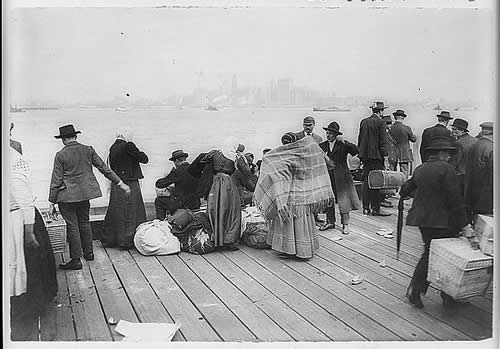
Immigrants Awaiting Transfer - Ellis Island (1912). | GGA Image ID # 2193acc3e7
Not at any other place in all the history of nations have so many silent dramas of the human heart as at Ellis Island. It is the door of hope to millions of European peasants who are saving their copper coins against a chance of entering there. It is the gate of new life to millions of adopted Americans who remember that there they were freed of countless terrors that their fathers deemed inescapable. And it has been the seat of doom to tens of thousands who have been turned away from its portals.
The Immigrant: An Asset and A Liability by Frederic J. Haskin, 1913, New York, Chapter 9: Landing at Ellis Island, Pages 74-82. This book is a reproduction of a series of articles which were published in a large list of newspapers throughout the United States. The material was taken largely from the exhaustive reports on immigration made by the federal government. Originally presented as the author's thesis (doctoral -- University of London).
Key Highlights and Engaging Content
One of the most engaging elements of the article is its emotional and physical depiction of the steerage passengers—the lower-class immigrants traveling in the ship’s steerage section. The author poignantly describes how these passengers, often battered by their journey, find hope upon glimpsing the Statue of Liberty and arriving in New York Harbor. The emotional weight of this moment is emphasized by the contrast between the optimistic sense of freedom and the dread of the bureaucratic process that awaits them on Ellis Island.
The section on the medical examinations is another compelling aspect. The detailed descriptions of the inspection process—how doctors would examine immigrants’ eyes, hands, and bodies—paint a vivid picture of the invasive and often humiliating procedures many immigrants endured. The mention of trachoma and other diseases, which led to deportation, highlights the harsh and discriminatory policies that disproportionately impacted certain groups.
The article also emphasizes the “stairway of separation” where families were torn apart, often with little explanation, as some were detained for further examination while others passed through. This emotionally charged passage showcases the psychological toll on immigrants, especially the heart-wrenching moments when families feared permanent separation.
Another key highlight is the focus on the “human dramas” that unfolded daily at Ellis Island. The author draws attention to the many silent struggles, from mothers who feared losing their children to immigrants who failed their medical exams or lied about their reasons for coming. These personal stories help humanize the otherwise impersonal system of immigration processing.
📸 Noteworthy Images
The images included in the article are essential in conveying the stark reality of the immigration process. The "Immigrant Landing Stage at Ellis Island" photo shows a tender bringing new immigrants to the island, highlighting the beginning of their journey through the bureaucratic system. This image encapsulates the sense of hope and uncertainty that marked the immigrant experience at Ellis Island.
The “Immigrants Undergo Medical Examination at Ellis Island” image captures the intensity and scrutiny that immigrants were subjected to during their medical inspections. The sterile, impersonal environment of Ellis Island is evident in the image, reinforcing the invasive nature of the process.
Another noteworthy image is the "Line of Female Immigrants Undergoing Inspection at Ellis Island", which offers a powerful visual of the immigrant women being inspected.
The image serves as a reminder of the gendered dimensions of immigration, where women were often subject to additional scrutiny for their supposed moral character, particularly regarding prostitution.
Educational and Historical Insights
The article provides valuable historical insights into the immigration process and the operations at Ellis Island. For example, the author touches on the immigration laws of the time, such as those related to health (e.g., the detection of diseases like trachoma) and moral character, both of which were grounds for deportation.
The detailed accounts of medical inspections, along with the mention of how immigrants often lied to pass their inspections, open a window into the strict and sometimes arbitrary nature of the system.
The depiction of the "stairway of separation" and the division between families highlights how the immigration process was not only a bureaucratic ordeal but also an emotional and psychological one for the immigrants involved.
The breakdown of deportation rates—such as the number of individuals rejected due to health issues or moral concerns—gives a quantitative perspective on the hardships immigrants faced.
The article also provides a critical historical perspective on the role of Ellis Island in shaping America's immigrant experience. The processing of immigrants at Ellis Island was both a gateway to new opportunities and a bureaucratic gauntlet that many had to navigate to reach their dreams of a new life in America.
Final Thoughts
Landing at Ellis Island is a poignant and thorough examination of the immigrant experience at one of the most iconic locations in U.S. immigration history.
The article offers rich, emotional narratives intertwined with factual details of the immigration process, making it a valuable resource for anyone studying U.S. immigration history.
It also serves as a powerful reminder of the sacrifices, hardships, and hopes that immigrants carried with them as they sought a better life in America.
🔎 Research & Essay Writing Using GG Archives
📢 This is NOT a blog! Instead, students and researchers are encouraged to use the GG Archives materials for academic and historical research.
🔎 Looking for primary sources on Titanic’s lifeboat disaster? GG Archives provides one of the most comprehensive visual collections available today.
